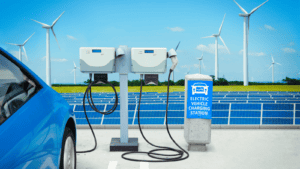The Bright Rise of Electric Vehicles
Hey there! Have you ever wondered about the increasing number of electric vehicles (EVs) you see on the road these days? From luxury Tesla sedans to the affordable Nissan Leaf, EVs are genuinely driving the future of transportation. They’re not just for tech enthusiasts but also an essential part of our commitment to climate change solutions and sustainable living. Let’s dive deep into the world of EVs and see what the buzz is all about!
The Emergence of Electric Vehicles: An In-depth Look at Their Features, Affordability, and Safety
As we swiftly advance into the future, the auto industry has seen an incredible transiAll Poststion towards using clean energy, prominently marked by the widespread adoption of the electric vehicle (EV). The past few years have witnessed a dramatic increase in electric vehicle sales. In 2023 alone, electric vehicles’ sales figures surged impressively, indicating consumers are more inclined to adopt green alternatives to traditional combustion engines.
The variety of electric vehicles available on the market is vast. For instance, manufacturers have developed electric cars with four doors to accommodate families and groups. The enhanced convenience and functionality offered by these 4-door electric cars have made them increasingly popular among consumers. By ensuring ample interior space without compromising on the environmental benefits, these electric cars are ideal for anyone looking to transition to greener transportation.
Regarding price range, there are ample options for consumers catering to various budgets. Electric cars are now available in multiple price brackets, making them accessible to more people. The market has seen several impressive electric vehicles under the $40k price range, showcasing an excellent mix of affordability and performance. One can find an array of electric cars for around $50k in the slightly higher price range. These cars often have premium features, cutting-edge technology, and superior performance capabilities.
One noteworthy development in the electric vehicle sector is the increased battery efficiency. Today, it’s possible to find an electric car that can drive 500 miles per charge, a significant improvement over the early stages of EVs. This remarkable development has made electric cars much more practical for daily commuting and long-distance travel.
However, the benefits of electric vehicles extend beyond personal cars. The golf industry, for example, has embraced the electric vehicle golf cart. This type of EV provides an efficient and eco-friendly way of traversing golf courses. With zero emissions and lower noise levels, electric golf carts contribute to a cleaner and quieter golfing experience.
While the electric vehicle market continues to thrive, it’s also essential to consider the safety aspects. For instance, although rare, electric vehicle fires can occur due to damage to the battery. Innovative solutions such as the electric vehicle fire blanket have been introduced to address this concern. These blankets are designed to smother and contain a fire if a battery ever becomes compromised, enhancing the safety of EV users.
The field of electric vehicles is also welcoming for those who wish to convert their existing traditional vehicles into EVs. An electric vehicle kit for cars allows car owners to make this transformation, promoting even wider adoption of green technology.
In conclusion, the surge in electric vehicle sales in 2023 can be attributed to many factors. These include an expanding range of affordable options, improvements in battery efficiency, the application of electric vehicles in various sectors, safety innovations, and the availability of electric vehicle conversion kits. As the world continues towards sustainability, the electric vehicle market is expected to keep growing, playing a crucial role in our greener future.
The Evolution of Electric Vehicles
EVs might seem like a recent invention, but the truth is, they’ve been around for quite a while. The history of EVs is packed with numerous vital milestones that have progressively shaped the EV technology we see today.
The first electric cars were developed as early as the 19th century but fell out of favor as gasoline cars dominated the market. Fast forward to the 21st century, the current status of the EV industry globally is booming, thanks to growing environmental consciousness, advancements in battery technology, and supportive government policies.
Understanding the Technology Behind EVs
Alright, let’s now peek under the hood. EVs run on an electric motor powered by a rechargeable battery pack. Unlike traditional gasoline cars, EVs don’t burn fuel to create motion, significantly boosting energy efficiency. EVs are also much simpler in design, resulting in fewer maintenance concerns – no oil changes are needed!
Of course, EV battery technology is a hot topic, being the heart of the vehicle. Rapid advancements in this field have led to longer driving ranges, shorter charging times, and overall improvements in EV performance.
The Environmental Impact of Electric Vehicles
Switching to EVs can help us dramatically lower emissions, contributing to cleaner air and a healthier environment. They’re also incredibly energy efficient, converting more energy from their power source into actual drive power.
However, it’s essential to discuss the full lifecycle assessment of EVs. Yes, there are environmental impacts during battery production and disposal. But these are mitigated over the life of the EV due to its significantly lower operational emissions. Ongoing research on recycling and repurposing used EV batterie is a promising development.
Major Players in the Electric Vehicle Market
The EV market is crowded with innovative companies driving the growth of sustainable transport. Let’s talk about Tesla, the poster child of EVs, whose technologically advanced models have significantly impacted the EV market growth. With its Leaf model, Nissan has made EVs accessible to the average consumer. And let’s not forget General Motors, which is making solid strides in the EV space with its commitment to launching multiple EV models in the coming years.
Government Policies and Initiatives Promoting EV Adoption
Governments worldwide are pushing for EV use with various policies and initiatives. Incentives like tax credits, subsidies, and building EV charging infrastructure encourage more and more people to go electric. Look at countries like Norway, which boasts high EV adoption rates thanks to robust government policies and public enthusiasm.
Challenges and the Road Ahead
No technology is without its challenges, and EVs are no exception. Battery life, the availability of charging infrastructure, and the initial cost of EVs are concerns. But fear not! The industry is actively addressing these issues, and we’re seeing positive changes with every passing year.
The future of EVs looks bright. With upcoming technologies and trends, we can expect EVs to become more efficient, affordable, and convenient. Whether it’s wireless charging, self-driving capabilities, or innovative battery tech, we’re on the brink of exciting times.
Conclusion
So, there you have it! EVs are more than just a fad; they’re significant players in the green technology movement, a beacon of hope for a sustainable future. I urge you to consider the switch to EVs, not just for your wallet but also for the planet. After all, if we want to keep enjoying our drive, we need a healthy Earth to drive on!
Call to Action
I hope this article has been insightful and ignited a spark of interest in you about EVs. If you liked it, don’t forget to share it with your friends, comment with your views, or subscribe to our newsletter for more updates on green technology trends.
FAQ
To wrap it up, let’s address some commonly asked questions:
Q: Are electric vehicles better for the environment? A: Absolutely! Even considering the entire lifecycle, including battery production and disposal, EVs still produce fewer emissions than conventional cars.
Q: What is the range of most electric vehicles? A: Most new electric cars can cover about 150-370 miles on a single charge. However, this range is constantly increasing as battery technology improves.
Q: How long do electric vehicle batteries last? A: Most manufacturers offer a battery warranty of 8 years or 100,000 miles. But with proper care, the batteries can last well beyond the warranty period.
Q: Is it expensive to charge an electric vehicle? A: Charging an EV is much cheaper than filling a car with gasoline. The cost can vary depending on where and when you charge, but on average, it’s about half the cost per mile compared to gasoline cars.
Stay tuned for more in-depth articles about green tech and its role in shaping a sustainable future. Keep driving the change!
Resources
https://en.wikipedia.org/wiki/Electric_vehicle
We’re reader-supported. We may earn an affiliate commission when you buy through links on our site.







